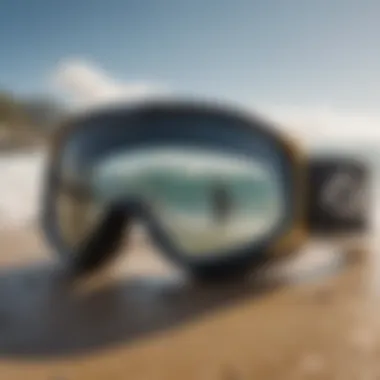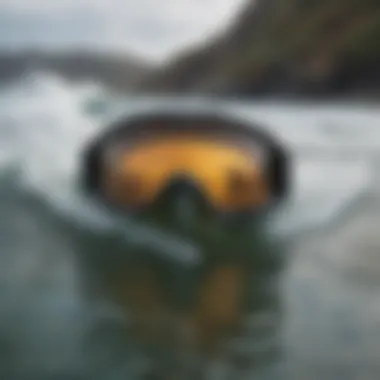Top Surfing Goggles: A Comprehensive Guide


Intro
Surfing, as an exhilarating extreme sport, demands not just skill but also the right equipment. Among this equipment, goggles play a crucial role in ensuring clear visibility and protecting eyes from harsh conditions. This comprehensive guide delves into the best goggles for surfing, analyzing factors such as design, lens technology, comfort, and durability. We aim to address the unique needs of surfers, from novices to veterans, as they navigate the sometimes unpredictable waters. By understanding the array of options available, surfers can select the most suitable goggles tailored to their conditions and preferences.
Equipment and Gear
When it comes to surfing, choosing the right equipment is essential. Beyond just boards and wetsuits, goggles represent a key component of a surfer's gear.
Overview of Essential Gear for Surfing
For surfers, several items are vital. These include:
- Surfboard: The primary tool of the sport, available in various shapes and sizes.
- Wetsuit: Provides thermal protection in cold water.
- Goggles: Protects eyes from saltwater and enhances visibility.
- Leash: Keeps the surfboard attached to the surfer.
- Surf Wax: Offers traction on the board.
Detailed Descriptions of Top Brands and Recommended Products
When selecting goggles, some brands stand out for their quality and performance. O'Neill offers goggles designed to withstand ocean conditions while providing comfort. Speedo is known for its high-quality lens technology, enhancing clarity. Zoggs focuses on eye protection against UV rays, ideal for long hours in the sun. Each of these brands has products tailored to different needs.
Tips on Maintenance, Upgrades, and New Advancements in Equipment
To extend the lifespan of goggles, careful maintenance is important.
- Rinse them with fresh water after use.
- Avoid touching the lens with fingers to prevent scratches.
- Store them in a protective case when not in use.
With advancements in technology, new features such as anti-fog coatings and polarized lenses are becoming standard. Regularly researching and upgrading your gear can keep you competitive on the water.
Techniques and Training
To maximize performance, a surfer must also focus on techniques and training.
Breakdown of Advanced Skills and Techniques for Surfing
Understanding and mastering different maneuvers is essential.
- Bottom Turn: Helps maintain speed and set up for the next move.
- Aerial Tricks: Advanced moves that add flair to your style.
- Cutbacks: Keeps you in the wave pocket for extended rides.
Training Exercises and Routines
Training is crucial for strength and agility. Workouts can include:
- Strength training targeting the core and legs.
- Flexibility exercises to improve balance.
- Endurance training for better stamina during long sessions.
Insight from Professional Athletes and Trainers
Learning from professionals can provide unique insights. Many athletes emphasize the importance of mental preparation and consistent practice. Engaging in local surf schools or clinics may provide valuable instruction and community support.
Safety and Risk Management
Safety should never be ignored in surfing.
Importance of Safety Protocols
Establishing safety protocols reduces risks. Consistent monitoring of wave conditions, currents, and local shark activity is essential.
Common Risks and Potential Hazards
Surfers need to be aware of:
- Riptides: Commonly occur and can be dangerous.
- Collision with Other Surfers: Maintaining awareness of your surroundings is key.
- Injuries: From the board or the ocean floor, proper technique can help.
Strategies for Risk Mitigation
Always surf with a buddy when possible. Keeping a personal flotation device nearby can also be wise. Familiarizing yourself with the surf area before entering the water can prevent accidents.


Lifestyle and Community
Surfing is not just a sport; it’s a lifestyle.
Features on Lifestyle Aspects
Surfers often develop a culture based on shared experiences. Maintaining a balanced lifestyle that includes fitness and mental well-being is important.
Tips for Balancing Surfing with a Healthy Lifestyle
Surfers should focus on nutrition and recovery to enhance performance. Incorporating rest days into a training regimen is essential for avoiding fatigue. It's also beneficial to engage in mindfulness and relaxation techniques to maintain mental clarity.
Understanding the Importance of Goggles for Surfing
Surfing is not just a sport; it is an experience that connects you to the ocean. However, the conditions in which surfers operate can be demanding and sometimes hazardous. Therefore, understanding the importance of goggles is crucial for anyone engaging in this activity. Goggles serve multiple purposes, primarily focused on eye protection, visibility enhancement, and comfort during long sessions in the water.
When surfers venture into the waves, their eyes are often exposed to a combination of saltwater, debris, and UV rays. This exposure can have detrimental effects, making the need for suitable goggles more apparent. Surf goggles are specially designed to tackle these challenges, ensuring a safe and enjoyable surfing experience.
Eye Protection in Saltwater
Saltwater can be harsh. Surfing without adequate eye protection can lead to immediate discomfort and long-term damage, such as irritation and corneal abrasion. Goggles create a barrier against the salt, preventing it from directly contacting the eyes. This is especially important while catching waves or navigating through turbulent waters, where splashes and surf can be unpredictable. With good goggles, surfers can focus on enjoying the ride without the distraction of stinging eyes. Also, lenses with UV protection reduce the risk of sun-related eye damage, which is an important health consideration for those spending prolonged periods outdoors.
Enhancing Visibility Underwater
Visibility can be severely compromised underwater. The dynamic nature of waves can create a chaotic environment, frequently disrupting a surfer's line of sight. Quality goggles enhance underwater clarity, allowing surfers to see clearly as they dive beneath the waves, which helps in avoiding obstacles and navigating swell patterns more effectively. Goggles with anti-fog coatings provide additional benefits, ensuring that mist does not obscure vision as the temperature changes between the cool water and the warmer air above. Improved visibility means better decision-making while surfing, which is essential for both safety and performance.
Comfort during Long Sessions
Surfers often spend hours in the water. Comfort is paramount during these extended sessions. Quality goggles are designed with features that prioritize comfort without sacrificing performance. Lighter materials and adjustable straps ensure that the goggles fit snugly without causing discomfort. Additionally, soft padding around the frame can minimize pressure on the face and reduce the risk of irritation after long hours in the water. The right goggles contribute to a more enjoyable surfing experience, letting surfers immerse themselves in their passion.
"Choosing the right goggles is as important as selecting your surfboard. It can significantly affect your performance and enjoyment in the water."
Criteria for Selecting Surf Goggles
Selecting the right goggles for surfing is essential for both safety and performance. The ocean can be a challenging environment, and the right lenses can significantly affect visibility while navigating through the waves. The criteria mentioned here focus on the core aspects that make surf goggles suitable for various conditions. Surfers, whether beginners or professionals, must weigh these factors to find the best match for their needs.
Lens Types and Technologies
Polarized Lenses
Polarized lenses are essential for reducing glare from the ocean's surface. This feature enhances vision clarity and reduces eye strain, allowing surfers to see better underwater. These lenses filter out horizontal light waves, deflecting intense glare. A clear view enhances performance during surfing, making polarized lenses a popular choice. Nonetheless, polarized lenses might limit visibility of some digital screens, which is an aspect to consider.
Anti-Fog Coatings
Anti-fog coatings are crucial for maintaining visibility over extended periods. These coatings prevent condensation from forming on the lenses, which can obstruct the view. Surfers often face temperature changes a lot during sessions, leading to fogging. A fog-free experience is vital, particularly in competitive situations. It's worth noting that some coatings require careful cleaning to maintain effectiveness, which may be a disadvantage for some users.
UV Protection
UV protection is another critical feature of surf goggles. Prolonged exposure to sunlight can cause damage to the eyes. Goggles with UV protection block harmful rays, ensuring a safer experience. Many manufacturers emphasize this characteristic, recognizing it as a fundamental requirement. Not having proper UV protection could potentially harm your eyesight over time, making it a non-negotiable aspect to look for.
Frame Design and Fit
Material Options
The material options for frames significantly affect durability and comfort. Common materials include polycarbonate and nylon, known for being lightweight and resilient. A strong frame withstands the impacts of surfing while providing comfort. A downside might be the rigidity of some materials, which could compromise comfort over prolonged use.
Adjustability Features
Adjustability features allow surfers to customize the fit of their goggles. Those features can include adjustable nose bridges and temple arms. An optimized fit improves stability and comfort during intense sessions. However, increased adjustability might add complexity, which could confuse some users when looking for straightforward solutions.
Weight Considerations
Weight is a factor often overlooked when selecting surf goggles. Lighter goggles reduce fatigue and provide a more freeing experience while in the water. A lightweight design offers better maneuverability and comfort. However, the temptation is to choose only the lightest options, which may sacrifice durability in harsher conditions.
Strap and Retention Systems


Silicone Straps
Silicone straps have become the preferred choice for many surfers due to their grip and flexibility. These straps conform better to varied head shapes, providing a secure fit. Good grip means less chance of losing goggles during intense activities. One consideration is that silicone may wear down over time, especially if exposed to the sun frequently.
Quick-Release Mechanisms
Quick-release mechanisms enhance the usability of surf goggles. This feature allows surfers to detach their goggles quickly in emergencies. An easily detachable strap is valuable for safety and convenience. However, some quick-release systems may not be as robust as traditional fixed straps, posing a risk during rough surf.
Compatibility with Other Gear
Compatibility with other gear, such as helmets or surf caps, is vital for cohesion in your sport setup. Goggles that work well with various equipment create ease of use and enhance safety. Compatibility can significantly affect the user's experience, especially if you prefer various gear. However, some goggles may not fit all accessories, requiring specific consideration when making selections.
Top Recommendations for Surfing Goggles
Selecting the right surf goggles can significantly enhance the surfing experience. In this section, we will delve into the top recommendations based on various factors that are essential for surfing. These factors include durability, comfort, and visual clarity. Each element contributes to the overall performance of the goggles, ensuring that surfers can concentrate on the waves without worrying about their eye protection. Here, we assess models that cater to different skill levels and conditions, making it easier for surfers to find the right pair for their needs.
Prime Features of Each Model
Durability
Durability is a critical aspect of any surfing goggle. Surfers often face harsh conditions such as saltwater, sun exposure, and frequent wear and tear. Hence, a pair with high durability can withstand these stresses. Polycarbonate lenses are a popular choice for their resistance to impact and scratches. Additionally, frames made from flexible materials, like nylon or rubber, provide not only strength but also flexibility, ensuring they withstand rough handling. A durable goggle will surely save you money in the long run by not needing frequent replacements.
Comfort Levels
Comfort levels are vital when selecting goggles. For those long surf sessions, surfers need goggles that fit snugly but do not cause discomfort. Features such as soft, foam padding around the eyes and adjustable straps can greatly enhance comfort. Good comfort levels allow for prolonged use without fatigue. Models that balance snugness with breathability help prevent overheating and sweating, leading to a better overall experience.
Visual Clarity
Visual clarity is arguably one of the most important features. It allows surfers to see clearly both above and below the water surface. Goggles with anti-reflective and anti-fog coatings improve vision significantly. High-quality lenses that are distortion-free enable crisp and clear viewing. Clear vision is essential for spotting waves and navigating underwater challenges. Low distortion at any angle ensures that surfers can react quickly and effectively.
Goggles for Beginners
For beginners, it is essential to choose goggles that combine affordability with fundamental features. Models that are designed for easy adjustment and good visibility make learning to surf more manageable. Often, these goggles come with simple, intuitive designs that do not compromise on performance.
Goggles for Advanced Surfers
Advanced surfers require goggles that caters to technical performance. High durability, superior comfort, and enhanced visual capabilities are essential for high-stakes surf conditions. Many advanced models are equipped with cutting-edge technology, including lens customization and superior fit, aiding surfers in maximizing their performance against the elements.
Goggles for Specific Conditions
Heavy Surf
In heavy surf conditions, goggles must have features that provide extra stability and reliability. Models designed for such conditions typically have a firm grip and a secure fit to avoid displacement during strong waves. Choices with robust frames help ensure that they can handle any impacts without compromising the vision. They also tend to have wider lenses for improved peripheral visibility.
Clear Water
For surf in clear water, the focus should be on visual clarity and UV protection. Goggles optimized for clear conditions often have a tint or mirrored lens to reduce glare from the water surface. Such features enhance contrast and provide greater depth perception, helping surfers spot obstacles easily underwater.
Bright Sun
Bright sun conditions necessitate goggles with polarized lenses. These lenses reduce glare from sunlight, which can be harsh on the eyes. Polarized options also improve overall visibility, creating a more comfortable surf experience. Surfers under the sun must carefully choose features that maximize protection while ensuring clear vision.
"The right goggles are not just an accessory; they are an essential part of the surfing gear that can impact performance and safety."
Using this detailed guidance on top recommendations for surfing goggles, surfers of all levels can make informed decisions based on their personal needs and unique surfing conditions.
Maintenance and Care for Surf Goggles
Maintaining surf goggles is crucial to their longevity and performance. Proper care enhances visibility, comfort, and ultimately the experience of surfing. When goggles are well-maintained, surfers can focus on the waves rather than distractions caused by dirty or damaged lenses. Regular maintenance also prevents issues that can arise from neglect, such as reduced clarity or damage that requires costly replacements. Understanding the care and maintenance of surf goggles helps users maximize their investment while ensuring safety.
Cleaning Techniques
Saltwater Rinsing


Saltwater can create residue on goggles, which may obstruct clear vision. One of the most effective cleaning techniques is saltwater rinsing. This method involves rinsing the goggles with fresh water immediately after use. By removing saltwater quickly, it helps prevent buildup that can impair visibility over time. The ease of this technique makes it a popular choice for many surfers. A unique feature of saltwater rinsing is its simplicity; it does not require special solutions or tools. However, if not done regularly, residues can become harder to remove, making future cleaning more challenging.
Storage Solutions
Storing goggles properly is another critical aspect of maintenance. Effective storage can prevent scratches and other damage. Using a protective case dedicated to goggles not only keeps lenses safe but also ensures that they remain dry and clean when not in use. Durable cases often have cushioning that protects against impacts. Poor storage choices may lead to damage, resulting in expensive repairs. Thus, investing in a good storage solution is beneficial in the long run.
Troubleshooting Common Issues
Fogging Problems
Fogging is a common issue that can significantly hinder visibility while surfing. It occurs when the temperature difference between the inside and outside of the goggles creates condensation. While some users may opt for anti-fog coatings, they may wear off over time. Recognizing fogging problems early allows surfers to take preventative measures. Frequent rinsing and avoiding prolonged exposure to extreme temperature shifts are simple remedies. Ignoring fogging can lead to dangers in the water, making this a crucial issue to address.
Seal Issues
A proper seal around the goggles is vital for preventing water from entering. Seal issues typically arise when the goggles are old or not fitting properly. A worn-out seal can lead to water leaking in, which distracts from the experience. Surfers should routinely check the seals for any sign of wear or damage. Regular inspection can help catch issues before they become significant problems. A secure fit ensures comfort and reduces the chances of distractions while riding the waves.
Future Trends in Surf Goggles Technology
The surfing landscape constantly evolves, reflecting new techniques and technologies that improve athletes’ performance. As such, the importance of staying updated with the latest trends in surf goggles technology cannot be overstated. These advancements not only enhance usability, but they also significantly contribute to safety and the overall experience of surfing. Surfers today are looking for gear that is functional, user-friendly, and environmentally responsible. With this in mind, we will examine some current and emerging trends that shape the future of surf eyewear.
Advancements in Lens Materials
Goggles are only as efficient as their lenses. Recent innovations focus on the materials used in lens production. For instance, polycarbonate and high-impact resistant materials are gaining attention for their lightweight and durable properties. These materials enhance protection against the elements while minimizing weight, allowing surfers to enjoy hours of use without discomfort.
Benefits of advanced lens materials include:
- Increased durability: Resistant to scratches and impacts.
- Improved visibility: Enhanced clarity for underwater explorations.
- Lightweight construction: Comfort during long surfing sessions.
Smart Goggles and Connectivity
A growing trend in surf technology is the integration of smart features into goggles. These innovations can provide surfers with real-time data, enhancing their experience on the water. Features may include GPS tracking, performance metrics, and even augmented reality displays. Smart goggles are designed to connect with smartphones and other devices, offering surfers a completely modernized approach.
Considerations for smart goggles include:
- User-friendly interface: Ease of access to information is crucial.
- Battery life: Essential for long days on the water.
- Durability: Smart components must withstand harsh surf conditions.
"Integration of smart technology into surfing gear opens new avenues for athletes to monitor their performance, ensuring they stay at the top of their game."
Sustainability in Manufacturing
As environmental awareness continues to rise, manufacturers are focusing on sustainable practices in goggles production. This includes using eco-friendly materials and processes that reduce waste and pollution. Initiatives such as recycling and minimizing harmful chemicals contribute to the manufacturing of goggle products that are kinder to the planet.
Key aspects of sustainability in surf goggles include:
- Recyclable materials: Reduction in plastic waste.
- Eco-conscious production methods: Limitation of harmful emissions.
- Longevity of products: Promoting durability to reduce the frequency of replacements.
Embracing these trends, both the surfing community and manufacturers can create a more sustainable future for the sport. By prioritizing innovation, connectivity, and eco-friendliness, surfers can enjoy enhanced experiences while protecting their environment.
Epilogue: Choosing the Right Goggles for Your Surfing Needs
Choosing the right goggles for surfing is critical. It impacts both performance and safety while in the water. Given the unpredictable nature of ocean conditions, goggles are not just accessories; they are essential tools designed to enhance one’s surfing experience.
Importance of Proper Goggles
Wearing appropriate goggles can make a significant difference. They protect the eyes from saltwater irritation, debris, and UV radiation. For long surf sessions, comfort is paramount. Therefore, finding a pair that fits well and remains comfortable is a priority. Quality goggles also improve visibility. This is especially important when navigating through waves or underwater.
Key Considerations
When selecting the right goggles, several factors should be evaluated:
- Lens Type: Options such as polarized lenses reduce glare and enhance visibility even in bright conditions.
- Frame Fit: A comfortable fit prevents water from seeping in. Check for adjustable straps and suitable materials.
- Anti-Fog Features: Most good goggles offer some level of anti-fogging technology. This is crucial for maintaining clear vision during surfing.
User Needs
Every surfer has distinct preferences. Beginners may prioritize affordability and ease of use, while advanced surfers might seek specialized features for specific conditions. Understanding your needs plays a significant role in making the right choice.
"The right goggles can elevate your surfing experience by improving visibility and ensuring comfort."
Final Thoughts
In summary, investing time in selecting suitable goggles is worthwhile. The right pair not only enhances comfort but also ensures safety, allowing surfers to focus on their performance. Explore options and make choices based on personal surfing conditions and preferences. This careful selection can lead to an improved experience in the water.













